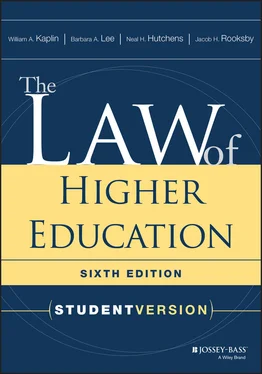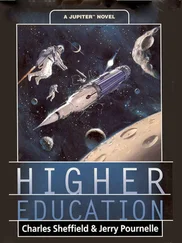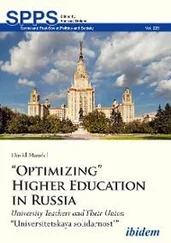An illustrative area in which state action questions have arisen in relation to private colleges and universities involves actions by campus police forces. In a case involving the University of Pennsylvania, a federal district court considered whether the university's campus police officers constituted state actors ( Fleck v. University of Pennsylvania , 995 F. Supp. 2d 390 (E.D. Pa. 2014)). Having determined that state law “endowe[d] the Penn Police Department with the plenary authority of a municipal police department” in areas on and near campus under its patrol authority, the court determined that the university's police offers qualified as state actors. In contrast, in Faiaz v. Colgate University , 64 F. Supp. 3d 336 (N.D.N.Y. 2014), the court rejected the argument that campus safety officers at a private university could be deemed to be acting under color of state law on the basis that at least one of the officers in question worked part-time at a local police department and because of cooperation between the campus safety department and the local police department. In distinguishing a previous case involving Cornell University police, Yaun v. Tops Market , 2012 WL 4491106 (N.D.N.Y September 28, 2012), the court said that the campus safety officers at Colgate were not “similarly deputized” under state law ( Faiaz , 64 F. Supp. 3d at 351). (For an additional case, one in which university police officers were found to be state actors, see Boyle v. Torres , 756 F. Supp. 2d 983 (N. Dist. Ill. 2010).) (For more on campus police departments, see Section 7.6.1.)
In the years since Rendell-Baker , the U.S. Supreme Court has, of course, also considered various other state action cases. One of its major decisions was in another education case, Brentwood Academy v. Tennessee Secondary School Athletic Association , 531 U.S. 288 (2001). Brentwood is particularly important because the Court advanced a new test—a fourth approach—for determining when a private entity may be found to be a state actor. The defendant Association, a private nonprofit membership organization composed of public and private high schools, regulated interscholastic sports throughout the state. Brentwood Academy, a private parochial high school and a member of the Association, had mailed athletic information to the homes of prospective student athletes. The Association's board of control, composed primarily of public school district officials and Tennessee State Board of Education officials, determined that the mailing violated the Association's recruitment rules; it therefore placed Brentwood on probation. Brentwood claimed that this action violated its equal protection and free speech rights under the federal Constitution. As a predicate to its constitutional claims, Brentwood argued that, because of the significant involvement of state officials and public school officials in the Association's operations, the Association was engaged in state action when it enforced its rules.
By a 5-4 vote, the U.S. Supreme Court agreed that the Association was engaged in state action. But the Court did not rely on Rendell-Baker or on any of the three analytical approaches sketched above. Instead, Justice Souter, writing for the majority, articulated a “pervasive entwinement” test under which a private entity will be found to be engaged in state action when “the relevant facts show pervasive entwinement to the point of largely overlapping identity” between the state and the private entity (531 U.S. at 303). The majority grounded this entwinement theory in Evans v. Newton , 382 U.S. 296 (1966), where the Court had “treated a nominally private entity as a state actor…when it is ‘entwined with governmental policies,’ or when government is ‘entwined in [its] management or control’” (531 U.S. at 296, quoting Evans , 382 U.S. at 299, 301). Following this approach, the Court held that “[t]he nominally private character of the Association is overborne by the pervasive entwinement of public institutions and public officials in its composition and workings…” (531 U.S. at 298).
The entwinement identified by the Court was of two types: “entwinement…from the bottom up” and “entwinement from the top down” (531 U.S. at 300). The former focused on the relationship between the public school members of the Association (the bottom) and the Association itself; the latter focused on the relationship between the State Board of Education (the top) and the Association. As for “entwinement…up,” 84 percent of the Association's members are public schools, and the Association is “overwhelmingly composed of public school officials who select representatives…, who in turn adopt and enforce the rules that make the system work” (531 U.S. at 299). “There would be no recognizable Association, legal or tangible, without the public school officials, who do not merely control but overwhelmingly perform all but the purely ministerial acts by which the Association exists and functions in practical terms” (531 U.S. at 300). As for “entwinement…down,” Tennessee State Board of Education members “are assigned ex officio to serve as members” of the Association's two governing boards (531 U.S. at 300). In addition, the Association's paid employees “are treated as state employees to the extent of being eligible for membership in the state retirement system” (531 U.S. at 300). The Court concluded that “[t]he entwinement down from the State Board is…unmistakable, just as the entwinement up from the member public schools is overwhelming.” Entwinement “to the degree shown here” required that the Association be “charged with a public character” as a state actor, and that its adoption and enforcement of athletics rules be “judged by constitutional standards” (531 U.S. at 302).
The most obvious application of Brentwood is to situations where state action issues arise with respect to an association of postsecondary institutions rather than an individual institution. But the Brentwood entwinement approach would also be pertinent in situations in which a state system of higher education is bringing a formerly private institution into the system, and an “entwinement up” analysis might be used to determine whether the private institution would become a state actor for purposes of the federal Constitution. Similarly, the entwinement approach might be useful in circumstances in which a postsecondary institution has created a captive organization, or affiliated with another organization outside the university, and the question is whether the captive or the affiliate would be considered a state actor.
1.5.2.2 When students, employees, and others may be engaged in state action.In addition to all the cases above, in which the question is whether a postsecondary institution was engaged in state action, there have also been cases on whether a particular student, employee, student organization, or affiliated entity—at a private or a public institution—was engaged in state action, as well as cases on whether a private individual or organization that cooperates with a public institution for some particular purpose was engaged in state action. While the cases focusing on the institution, as discussed in Section 1.5.2.1above, are primarily of interest to ostensibly private institutions, the state action cases focusing on individuals and organizations can be pertinent to public institutions as well as private.
In a case involving both students and an employee (a dean), Leeds v. Meltz , 898 F. Supp. 146 (E.D.N.Y. 1995), affirmed , 85 F.3d 51 (2d Cir. 1996), Leeds, a graduate of the City University of New York (CUNY) School of Law (a public law school) submitted an advertisement for printing in the law school's newspaper. The student editors rejected the advertisement because they believed it could subject them to a defamation lawsuit. Leeds sued the student editors and the acting dean of the law school, asserting that the rejection of his advertisement violated his free speech rights. The federal district court, relying on Rendell-Baker v. Kohn , held that neither the student editors nor the dean were engaged in state action. Law school employees exercised little or no control over the publications or activities of the editors. Although the student paper was funded in part with mandatory student activity fees, this did not make the student editors' actions attributable to the CUNY administration or to the state. (For other student newspaper cases on this point, see Section 10.3.3 of this book.) The court granted the defendants' motion to dismiss, stating that the plaintiff's allegations failed to support any plausible inference of state action. The appellate court affirmed the district court's dismissal of the case, emphasizing that the CUNY administration had issued a memo prior to the litigation disclaiming any right to control student publications, even those financed through student activity fees.
Читать дальше












